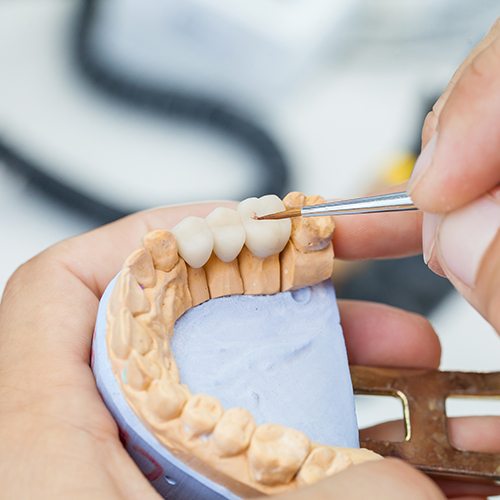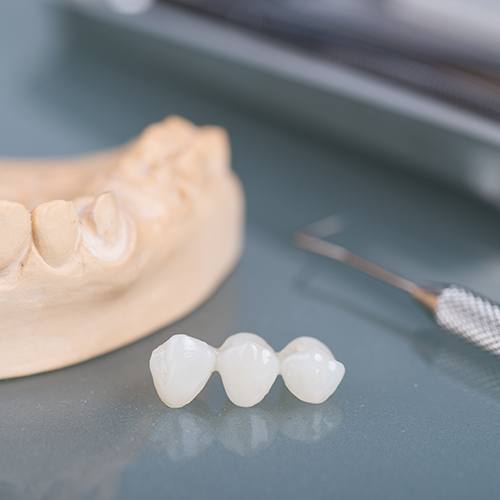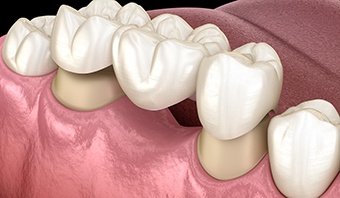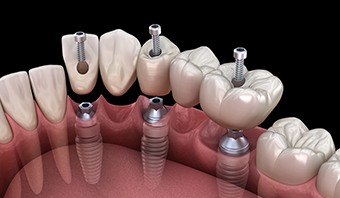
Dental Bridges – Indian Land, SC
Getting Rid of Gapped Smiles

While losing one tooth is bad, missing several adjacent ones is even worse. The problem leads to very apparent smile gaps that harm your looks and health alike. Fortunately, we at BridgeMill Dental Care have just the solution for this issue: dental bridges in Indian Land! Our team can use them to fill your mouth’s empty spaces, bringing your smile back to normal. Learn more about them and how they work by reading below, or book a consultation at our office.
What is a Dental Bridge?

A dental bridge is an oral device that can restore several lost teeth. In terms of design, it’s made of varied materials fused to either side of an artificial tooth. That setup allows it to replace one to four missing teeth, “bridging” large gaps in your smile.
Given the points above, the best dental bridge candidates lack several adjacent teeth. Treatment for these patients can restore a full smile with just one “session.” However, most adults can qualify for dental bridge; they just need to have good oral health first.
The Types of Dental Bridges

Our dentists will assess your smile at your consultation, using the results to see if a dental bridge suits you. From there, we may suggest one of two types to you:
Traditional Dental Bridge

The traditional dental bridge suits patients who’ve lost one to three teeth in a row. As for its makeup, it consists of dental crowns fused to either side of a pontic (i.e., an artificial tooth). This design forces the traditional bridge to use nearby natural teeth to stay secure.
Compared to the other kind, a traditional bridge often costs less. It uses more common materials and takes less time to place. On the other hand, this bridge also alters your existing teeth for placement.
Implant Bridge

Instead of dental crowns, an implant bridge uses dental implants – metal posts set in your jaw. Those posts fuse with your jawbone to ensure the larger restoration remains stable. As a result, the final implant bridge shouldn’t fall, slip, or loosen over time.
Unlike the regular kind, an implant bridge doesn’t alter your existing teeth. The treating dentist won’t change your current dental structure for its placement. In exchange, though, this bridge costs more than the standard model.
The Benefits of Getting a Dental Bridge

By getting a dental bridge at BridgeMill Dental Care, you’ll enjoy perks like:
- A Healthier Mouth – When dental bridges fill smile gaps, they stop the spread of harmful bacteria. That means they lower your risk of gum disease and other oral issues.
- Better Looks – Dental bridges blend seamlessly with your smile thanks to their quality materials. They look so natural that most people won’t notice you have one.
- Easier Eating – A dental bridge uses strong materials for its teeth, so it helps you chew food more easily.
- Long-Lasting Results – Even the average dental bridge can last anywhere from 5 to 15 years. Meanwhile, a bridge that's given proper care can work for over 20 years!
You don’t need to live with unsightly spaces in your mouth. Instead, consider visiting us for dental bridges in Indian Land!
Dental Bridges FAQs
It is important to replace missing adult teeth, even if they’re not missing from an obvious place or visible when you speak or smile. Dental bridges are an excellent way to restore multiple consecutive teeth without the need for dentures or dental implants. Your new bridge will not only look like your real teeth, but it also has the benefit of functioning just like real teeth do, too. Here are a few commonly asked questions about this treatment. If you don’t see the answer to yours below, please contact our office for more information.
Can You Take a Dental Bridge Out?
No, you cannot take your dental bridge out, as these prosthetics are not designed to be removed. Should yours need to be removed due to age or damage, your dentist will need to do this.
You may have heard of a restoration called a “removable bridge” however this refers to a partial denture, which can be removed by the patient at any time. Real bridges cannot be removed at home.
What Are Dental Bridges Made Of?
Your new dental bridge from BridgeMill Dental Care will be carefully crafted from tooth-colored materials such as those used in dental crowns. These are great for front and back teeth because they can blend in seamlessly with the rest of your smile. They are also very durable, so you can use them to eat a wide variety of healthy, delicious foods!
How Many Teeth Can a Dental Bridge Replace?
Depending on how many teeth you need to replace, your bridge can hold between one and four in a row. However, in most cases bridges are only used to replace one or two teeth. This is because the longer your bridge needs to extend, the less stable it can become, especially if the anchor teeth supporting the bridge aren’t strong and healthy.
To replace more teeth, your dentist may recommend an implant bridge. These are just as strong and secure as your natural teeth, if not more so!
Can Dental Bridges Be Whitened?
No, unfortunately your dental bridge cannot be professionally whitened. That’s because while your natural tooth enamel has tiny pores for bleaching gels to enter and break up stains, your bridges do not. Thus, your bridge should always remain the same color.
If you notice that your natural teeth are becoming discolored in contrast with your dental bridge, speak to your dentist about professional whitening for your real teeth. If you would like to start off with a whiter smile, consider a whitening treatment before you get your bridge so that your dentist can match the prosthetic to your whitest smile!